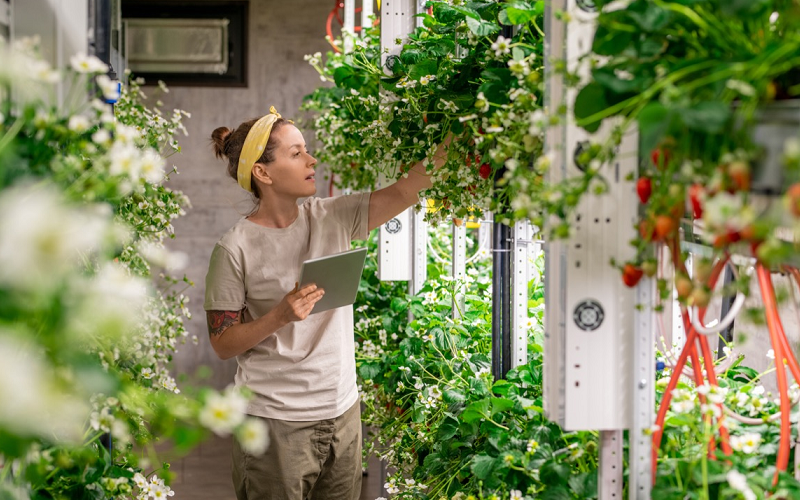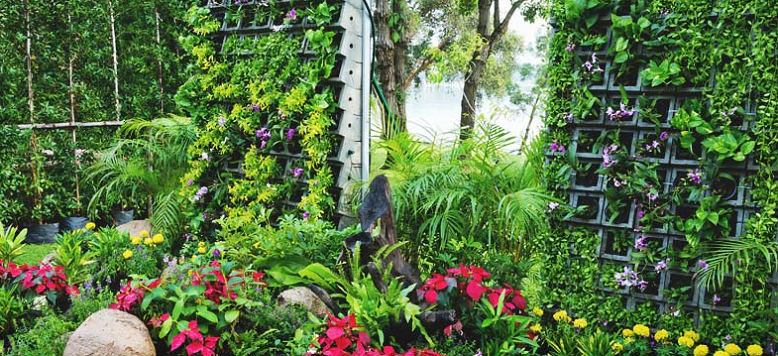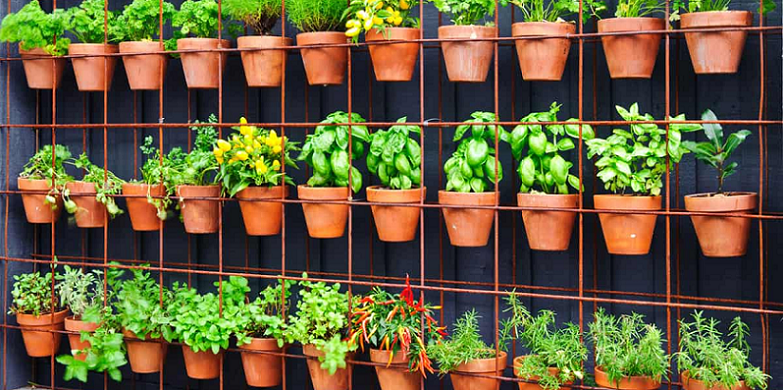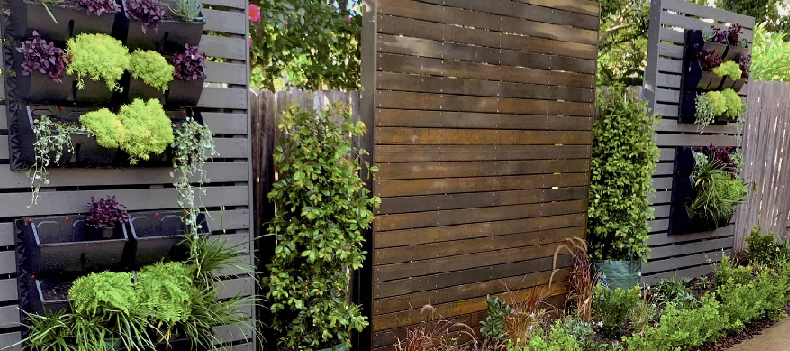
As more people move to urban areas, gardening space becomes a precious commodity. But what if you could grow your own fresh produce in a small space? Vertical gardening may be the solution you’re looking for. This innovative gardening technique involves growing plants vertically on walls, trellises, or towers, allowing you to maximize your space and increase your yield. Here we explore the benefits of vertical gardening, different types of vertical gardens, how to create your own, and tips for maximizing your space and yield with vertical planting.
What Is Vertical Gardening?
Vertical gardening is a gardening technique that involves growing plants vertically, often on walls, trellises, or towers. This method is becoming increasingly popular in urban areas where space is limited. By using vertical space, gardeners can maximize their growing area and yield.
Plants can be grown in a variety of containers, including pots, hanging baskets, and even old shoe organizers. This technique allows gardeners to grow a wide variety of plants, including vegetables, herbs, and flowers, in a small space. In addition to its practical benefits, vertical gardening can also be a creative and visually appealing way to add greenery to any space.
There are many types of vertical gardens, including wall-mounted gardens, trellis-based gardens, tower gardens, and hanging gardens, which can be customized to fit any space or style.
Vertical gardening is a versatile and efficient way to grow plants, no matter how small your living space may be.

Types of Vertical Gardening
There are several types of vertical gardening, each with its own unique features and benefits. Some of the most common types of vertical gardening include:
- Wall-mounted gardens: Wall-mounted gardens are a great way to bring greenery to an otherwise barren wall. This type of vertical garden can be created using a variety of materials, such as wooden pallets, plastic panels, or hanging pots. Wall-mounted gardens are ideal for herbs, small vegetables, or flowering plants.
- Trellis-based gardens: Trellis-based gardens use a lattice or trellis structure to support climbing plants. This type of vertical garden is perfect for vining plants such as tomatoes, beans, and cucumbers. The trellis structure can be made from wood, metal, or PVC pipe, and can be installed in the ground or in a container.
- Tower gardens: Tower gardens are vertical gardens that are built using a series of stacked containers. Each container has holes cut out of the sides, allowing plants to grow through the openings. Tower gardens can be made using plastic containers or even PVC pipe. They are ideal for growing a variety of herbs, leafy greens, and small vegetables.
- Hanging gardens: Hanging gardens are a popular type of vertical gardening that involves hanging pots or baskets from a structure or hook. This type of vertical garden is perfect for small spaces, as it allows gardeners to make use of vertical space that might otherwise go unused. Hanging gardens can be used to grow a variety of plants, including herbs, flowers, and small vegetables.

Choosing Plants for Vertical Gardening
When choosing plants for vertical gardening, there are several factors to consider. First, you’ll want to choose plants that are well-suited to growing vertically, such as those that are naturally vining or have shallow root systems. Some good choices for vertical gardening include herbs like thyme, oregano, and basil, leafy greens like lettuce and spinach, and vining plants like tomatoes, beans, and cucumbers.
Next, it’s important to consider the amount of sunlight your vertical garden will receive. Most plants require at least 6 hours of direct sunlight per day, so be sure to choose plants that are well-suited to the amount of light your space receives. You’ll want to consider the size of the plants you choose, as smaller plants will be easier to support in a vertical garden.
When selecting plants for your vertical garden, it’s also important to think about the amount of maintenance they will require. Some plants, like herbs and leafy greens, are relatively low-maintenance and can be grown in small containers, while others, like tomatoes and cucumbers, may require more space and attention.
Finally, consider the growing conditions of your space, including the temperature and humidity levels. Plants that are well-suited to your climate and growing conditions are more likely to thrive in a vertical garden.
Choosing the right plants for your vertical garden is an important part of ensuring its success. By considering factors like plant size, light requirements, and maintenance needs, you can select plants that are well-suited to your space and goals.

How to Create a Vertical Garden
Creating a vertical garden might seem like a daunting task, but with proper planning and the right materials, it’s actually quite achievable. The first step is to plan and design the garden. Decide on the size and location of the garden, and take into account the amount of sunlight that the space receives. Make a sketch of the plan for the garden, including the materials and structure required.
Next, gather the necessary materials and tools. This will depend on the type of garden you want to create. You may need containers, soil, plants, and support structures like trellises or hooks. Depending on the structure you plan to build, you may also require tools like a saw, drill, or hammer.
Once you have everything you need, it’s time to build the structure. This could involve installing a trellis or lattice on a wall, stacking containers to create a tower garden, or hanging pots or baskets from a hook or structure. Make sure the structure is sturdy and able to support the weight of the plants and soil.
Next, fill the containers with soil and compost, leaving enough space for the plants to grow. If you plan to plant directly into the soil, make sure the soil is well-draining and nutrient-rich.
Now, it’s time to plant your vertical garden. Carefully choose and plant the desired plants, making sure to follow the planting instructions for each type of plant. Keep in mind the amount of space each plant will need to grow and mature.
Once the garden is planted, it’s important to maintain it. This may involve regular watering, pruning, and fertilizing, as well as monitoring the health of your plants for pests or disease. With regular care and attention, your vertical garden will thrive, producing fresh herbs, vegetables, and flowers in a small space.
Maximizing Space and Yield with Vertical Planting
One of the primary benefits of vertical gardening is the ability to maximize space and increase yield. Because vertical gardening uses the vertical space rather than taking up ground space, gardeners can grow more plants in a smaller area. By using techniques like trellising, stacking containers, or hanging baskets, it’s possible to grow a large variety of plants in a limited amount of space.
To maximize space in a vertical garden, gardeners can choose compact or dwarf varieties of plants. These plants are smaller and require less space to grow, making them ideal for vertical gardening. Some plants can be trained to grow vertically, like tomatoes, beans, and cucumbers. These vining plants can be trained to climb up trellises or other support structures, freeing up ground space and increasing the yield of the garden.
Another way to increase yield with vertical planting is to use companion planting techniques. Companion planting is the practice of planting two or more types of plants together that benefit each other in some way. For example, planting marigolds near tomato plants can help deter pests, leading to healthier plants and higher yields. Similarly, planting beans near corn can help the beans climb the cornstalks, freeing up ground space and increasing the overall yield of the garden.
In addition to maximizing space and yield, vertical gardening has other benefits as well. Because plants are grown off the ground, they are less susceptible to pests and diseases. Vertical gardening also makes it easier to harvest plants, as they are easily visible and accessible. And finally, because vertical gardens are often grown in containers, they can be moved to different locations if necessary, making them a versatile and flexible gardening solution.
Creative Ideas for Vertical Gardening
Vertical gardening is a technique that opens up a wide range of creative possibilities. These ideas can help gardeners create a unique and visually appealing vertical garden.
One popular approach is the vertical wall garden. This technique involves attaching planters to a wall to create a living wall of plants. Living walls can feature a variety of plants, from tropical plants to succulents and ferns. These vertical gardens can be a stunning and artistic addition to any space.
Another creative idea is DIY trellis structures. These can be a cost-effective way to support vining plants like tomatoes and cucumbers. They can be made from materials such as bamboo, wire, or wooden poles. The trellis structure can be shaped in unique ways to add an artistic element to the garden.
A vertical herb garden is a great choice for those who love cooking. Herbs are typically small and do not require much space to grow. This type of garden can be created using a simple hanging basket or by repurposing an old shoe organizer. Herbs such as basil, thyme, and parsley can be grown in a compact space, providing fresh and aromatic herbs for cooking.
Tiered container gardens are another option. These gardens involve stacking containers on top of each other, with the largest container at the bottom and progressively smaller containers stacked on top. This is an excellent way to maximize space in a small garden. Gardeners can grow a variety of plants using this method, including vegetables, flowers, and herbs.
Finally, a hydroponic tower garden can be a fun and creative way to experiment with a soilless growing technique. This method involves growing plants in a vertical tower, which can be made using PVC pipe or other materials. Water and nutrients are circulated through the system to feed the plants. This technique is ideal for growing leafy greens, herbs, and small vegetables.
